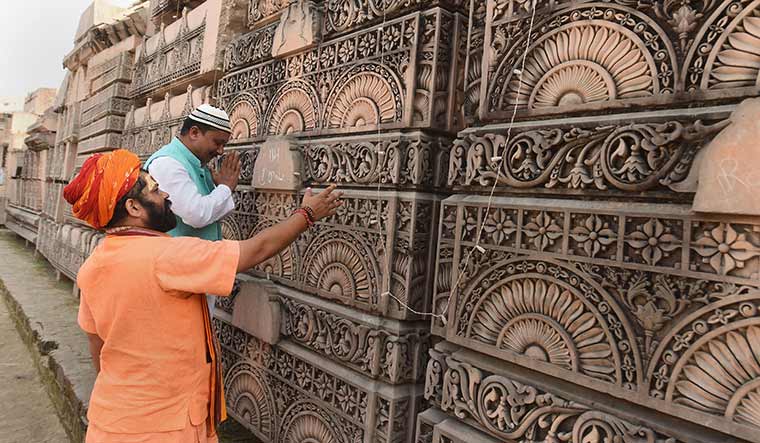AFTER THE SUPREME Court’s Ayodhya verdict, Chandrakant Baldevbhai Sompura is once again in the limelight. The 76-year-old architect of the proposed Ram Janmabhumi temple has no formal training in architecture, but has designed more than 100 temples like the Akshardham temple in Gandhinagar. The Ahmedabad-based Sompura was trained by his grandfather Prabhashankar, who had redesigned the Somnath temple.
In 1989, Vishva Hindu Parishad leader Ashok Singhal commissioned Sompura to design the Ram temple. Sompura said he was taken to the disputed site in Ayodhya and was asked to measure it without a tape. So, he walked the site and measured it in paces.
In an exclusive interview with THE WEEK, Sompura speaks about the design, the features, the speciality and the uniqueness of the Ram temple.
Excerpts:
What was the image that you had in mind while designing the Ram Janmabhumi temple?
Lord Ram is one of the swaroops of Lord Vishnu. So the garbh gruh (sanctum sanctorum) is octagonal in shape and so is the shikhar (spire). There are very few temples in India that are octagonal and there are no octagonal Ram temples. The parikrama (circumambulatory path) will be round; square shape is also included. So Brahma, Vishnu and Mahesh are included.
How big will the temple be?
There are limitations when you are making a stone temple. You will not get a stone which is more than 15 to 20 feet in length. You have to remain within the confines of these limitations. If you need a hall of 150x150 square feet, then it can be only be made of RCC (reinforced cement concrete). In this temple, at a time, 400 to 500 people can be accommodated. On occasions, there may be as many as three lakh pilgrims in a single day, but they will keep moving after having darshan.
How long did it take to finalise the design?
It took six months.
What are its unique features?
There are temples everywhere, but this is the Ram Janmabhumi temple. It will have rich carvings based on the Nagara shaily (style). There will be 250 pillars and each one will have 16 murthis (images) of gods and goddesses, dasavatars (the ten avatars of Vishnu) and Surya avatars. The life sketch of Ram will also be shown. It will be based on columns and beams. The temple will be a two-storey structure. The ground floor will have the idol of Ram Lalla, while the idols of Ram, Lakshman and Sita will be on the first floor.
Is the structure earthquake proof?
Yes. The stones will be joined in such a manner that they will not move. We are using the tongue-and-groove joint. Cement mortar and copper clamping between stones will be there. The total construction will need 2.5 lakh cubic feet of stone. These are pink stone/sandstone sourced from the Bansiphadpur area of Rajasthan’s Bharatpur district.
What is the expected lifespan of the temple?
If the temple is kept clean, then it will last for about 1,000 years. Take, for example, the Akshardham temple in Gandhinagar, which I made in 1985. Every year, devotees clean it by performing kar seva. It has to be cleaned by brush. You do not even require water.
How long will it take to build the temple?
Normally, it takes five years. However, stones for the two storeys have already been sculpted. Those were made in three workshops in Rajasthan and one in Ayodhya. So, it will take two and a half years to three years if we work for eight hours a day. We will require 1,500 to 2,000 stonemasons.
Before starting the construction, the land will have to be studied as the Sarayu flows close by. If the groundwater level is high and the soil’s load-bearing capacity is not much, then a special foundation will be needed.
Also read
- Ayodhya's traders turn to Hanuman to rescue them from being uprooted for the Ram temple
- Ayodhya Ram Mandir's garb griha has a Muslim connection
- ‘Don’t donate silver bricks, bank lockers have no space’: Ram Mandir Trust
- Land ownership plea not related to Dhannipur, says official
- Work on laying foundations for Ram temple in Ayodhya to begin after Dec 15
- A(Yodh)Ya—The land of no conflict
- Ram mandir: Digivijaya sharpens attack on PM Modi over 'inauspicious mahurat'
- Mosques in Ayodhya spread message of communal harmony ahead of Ram temple's bhoomi pujan'
What will be the dimensions of the temple?
It will be 270 feet long, 140 feet wide and 141 feet high.
Will foreign technology be used?
We are not going to use foreign technology except, if required, in lighting. There is no technology available abroad to carve stones like we do in India.
Were you sure you wanted to use stones?
Yes. Ninety per cent of our temples are made of stones. Even in our homes, the concrete structures give in after 40 to 50 years. There is not much life if iron is used.
Did you agree on a fee for the project?
Singhal had asked me to sign an agreement, which he said would ensure that there would always be an organisation (VHP) irrespective of whether he was there or not. So far, I have only claimed expenses for travel and paperwork. I have not charged anything else in the past 15 years. It is a service.
What else will be there in the temple complex?
There will be temples of Lakshman, Bharat, Ganesh and Sita. There will be a katha kunj, where stories from the Ramayan will be told. It will be bigger than the temple, and will seat 2,500 to 3,000 people. The complex will also have a research centre, a sant nivas, a canteen and an administrative building. This plan is for six acres. Other facilities will depend on the space we get.



